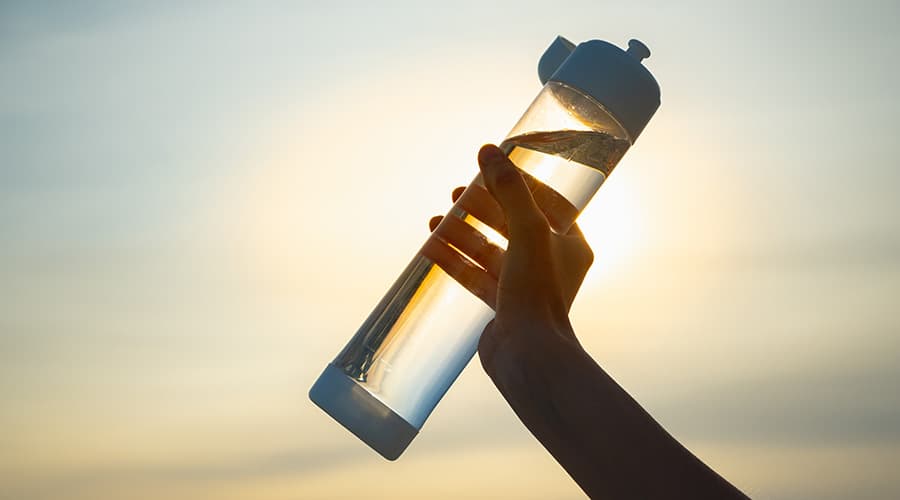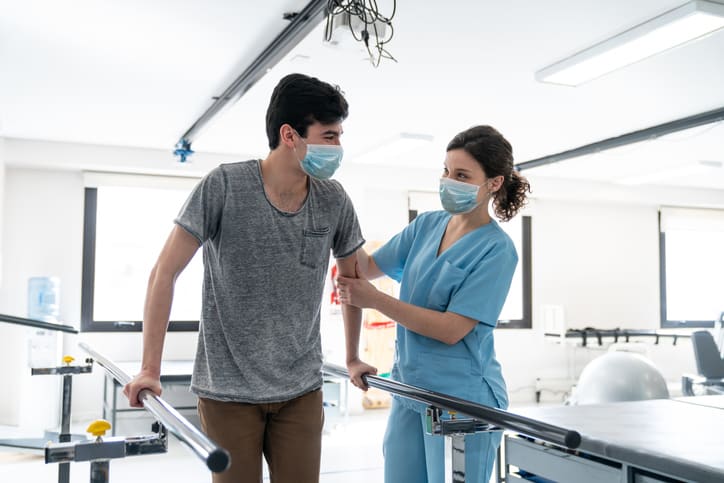
As the sweltering summer encroaches, the importance of drinking adequate fluids is critical in preventing dehydration.
When we are losing more fluids than taking in, our bodies do not have enough fluids to function correctly. Dehydration can be mild, moderate, or life-threatening, depending on the amount of fluid loss. All living organisms need water to survive. Up to 60% of the human adult body is water. The brain and the heart are comprised of 73% water, and the lungs are approximately 83% water. The skin contains 64% water, muscles and kidneys are 79% water. Even our bones are watery at 31%.
Water-Essential for Function
Water or other fluids serve essential functions for sustaining life, such as:
- Regulation of our body temperature through sweating and respiration
- A critical nutrient for every cell acting as a building substance
- Assists in flushing waste primarily through urination
- Lubricates joints
- Functions as a shock absorber for our brain, spinal cord and fetus
- Forms saliva
- Carbohydrates and proteins are metabolized and transported by water through our bloodstream
- Manufactures hormones and neurotransmitters in the brain
- Helps deliver oxygen all over the body
- Moistens mucosal membranes
- Aids in digesting food
- Improves sleep quality, cognition, and mood
According to Dr. Jeffrey Utz of Allegheny University, babies have the most water with about 78% at birth, and by one year, it drops to 65%. In adult men, approximately 60% of their bodies comprise water. In adult women, fat constitutes more of the body than men, leaving about 55% of their bodies comprised of water. To summarize:
- As a percentage, babies and children have more water than adults.
- As a percentage, men have more water than women.
- As a percentage, people with more fatty tissue have less water than people with less fatty tissue.
How Much Water Do We Need?
The amount of water required varies according to age, gender, climate, and occupation. As a rule, adult males need 3.2 quarts (3 liters) per day, while an adult female requires 2.3 quarts (2.2 liters) per day. We can consume certain foods, such as fruits and vegetables, that contain water for adequate hydration.
Signs and Symptoms
For adults, the early signs and symptoms include:
- Thirst
- Dry mouth and tongue
- Reduced urine output with darkening urine
- Lightheadedness, Confusion
- Muscle Cramps
- Fatigue, Sleepiness
- Headaches
More severe signs include:
- Excessive dry skin
- Rapid heartbeat
- Rapid breathing
- Irritability
- Fainting
In infants or young children, the signs include:
- Dry mouth and tongue
- Absence of tears when crying
- No wet diapers for three hours or more
- Sunken eyes and cheeks
- Sunken soft spot on top of the skull
- Listlessness or irritability
Causes
Dehydration can occur among anyone; however, young children and older adults are at higher risk. Neglecting to drink when we are busy, traveling, hiking, or when lacking access to clean water are common causes of dehydration.
Other causes of dehydration include:
Vomiting, Diarrhea: Sudden acute, severe diarrhea can cause substantial fluid and electrolyte loss in a short period. The combination of vomiting and diarrhea can lead to extreme fluid and mineral loss. Globally, more than four million children die each year from diarrhea.
Fever: The higher the temperature, in combination with vomiting and diarrhea, the higher the risk for dehydration.
Excessive Sweating: Hot, humid weather increases the amount we sweat and the amount of fluid loss. Vigorous exercise in the heat without drinking can result in dehydration.
Increased Urination: Undiagnosed or uncontrolled diabetes can result in dehydration. Certain medications such as diuretics and anti-hypertensives (blood pressure) can cause dehydration due to an increase in urination.
Burns: The skin acts as a protective barrier and regulates fluid loss. Burn victims are at risk for dehydration because damaged skin cannot prevent fluid loss from oozing out of the body.
Inability to drink fluids: Dysphagia is when a person has difficulty or discomfort swallowing liquids and food. Estimates of the prevalence of dysphagia is 13 million people in the United States. Dysphagia often results in inadequate fluid intake and dehydration. Complications such as aspiration, pneumonia, delirium, and urinary tract infections can also occur with dysphagia.
Populations at Risk
Infants and Young Children: The temperature regulation and sweat mechanisms of infants are not well developed, resulting in greater vulnerability for heat-related illnesses. Infants and young children are unable to communicate their thirst and are dependent on parents and caregivers for adequate fluid intake. Furthermore, vomiting and diarrhea can increase the risk of dehydration.
Older Adults: With aging, the body’s fluid reserve diminishes and becomes less efficient at regulating temperature. The ability to conserve water is compromised, and the thirst sense becomes less sensitive. Older adults may have limited mobility making it difficult to access water. Additional factors such as diabetes, medication side effects, and cognitive decline can increase the risk for dehydration.
Chronic Illness: Diabetes, kidney disease, medications that increase urine output, and a sore throat that makes drinking and eating painful can increase dehydration risk.
Outdoor work and exercise: When the air is humid, sweat cannot evaporate and cool us as quickly as usual, thus increasing body temperature and the need for fluids.
Higher altitudes: At 6,000 feet above sea level, we exhale and sweat twice as much as at sea level. There is a lower air pressure at higher altitudes with an increase in the rapid evaporation of moisture from the skin surface and the lungs. Most high altitudes are low in humidity, which further accelerates evaporation. The higher the altitude, the more water is required for our body to function.
Complications
Heat Injury: Without adequate fluid intake during vigorous exercise and heavy perspiration, heat injury can occur, ranging in severity from mild heat cramps to heat exhaustion or the possibility of life-threatening heatstroke.
Urinary and kidney problems: Protracted and frequent spells of dehydration can result in kidney stones, urinary tract infections, and kidney failure.
Seizures: When electrolytes (potassium and sodium) are out of balance, the usual electrical messages become disrupted, leading to involuntary muscle contractions and potential loss of consciousness.
Low blood volume shock (hypovolemic shock) is an emergency in which severe blood or other fluid loss makes the heart unable to pump enough blood to the body. This type of shock can lead to organ failure.
How to Prevent Dehydration During Hot/Humid Weather
- Drink plenty of water before going outside and eat a banana or drink coconut water, both rich in potassium, which helps regulate body fluid.
- Schedule regular beverage breaks and keep a water bottle available for frequent sips of water.
- Consider electrolyte-replacing drinks for maximum water absorption when exercising for more than an hour or when sweating profusely.
- Drink water after completing work or an exercise session.
- Snack on fresh fruits that contain large amounts of water such as berries, grapes, watermelons, peaches, and nectarines.
- Do NOT drink large quantities of plain water all at once, as this can result in hyponatremia or water-toxicity when sodium levels drop too quickly. This condition can become a medical emergency and is often fatal. Hyponatremia occurs in marathon runners and other endurance athletes.
- Coffee, caffeinated teas, alcohol, soft drinks, and energy drinks are NOT substitutes for water.
- Avoid sun in the middle of the day; exercise in the morning and evening when the weather is cooler.
- Apply sunscreen, wear a hat, or use an umbrella for sun protection.
- Wear thin, loose clothing that allows for airflow and helps sweat evaporate. Avoid dark clothing, which absorbs more heat.
Treatment for Dehydration
- Oral fluid replacement is the first line of treatment, including small, frequent sips of water. In severe cases of dehydration, intravenous fluids are necessary.
- Water: for infants, water alone is not safe to use as it can lead to significant electrolyte imbalances. Recommendations include Pedialyte or Gatorade for infants and children.
- Clear broths
- Popsicles
- Jell-O
- Gatorade or other sports drinks without caffeine and sugar
- Heat Cramps: Muscle cramps indicate dehydration. The individual should be moved into the shade and offered water, or Gatorade diluted with water.
- Heat exhaustion: Profuse sweating is an indicator of heat exhaustion, and can be critical. Move the individual to a cooler place, and remove his/her hat, untuck and unbutton a shirt to allow fresh air to reduce the body temperature. Offer small sips of water to avoid vomiting.
- Heatstroke: A lack of sweating, bright red skin, a flushed face, lethargy, and slurred speech are symptoms of heatstroke. Heatstroke is a severe medical emergency requiring immediate treatment; call 911 and apply cold compresses to the groin and armpits to lower core temperature. Do not immerse the body in cold water as this can shock the heart out of rhythm.
Complications of Dehydration
- Kidney failure
- Coma
- Shock
- Electrolyte Abnormalities
- Heat-related illnesses
- Urinary Tract Infections
- Orthostatic Hypotension
- Acute Mountain Sickness
- Hyperglycemia
- Oral Thrush
- Exercised-Induced Asthma
Conclusion
Dehydration can become a critical medical emergency, especially in the summer months, and fatal in some cases. Older adults and infants/young children are at the highest risk for dehydration and complications. Nevertheless, with awareness about the dangers and preventative measures, dehydration can be averted. Caregivers of both older adults and infants/young children need to ensure that adequate hydration becomes a priority.
References
- Csatari, J. (June/July 2020). AARP: How To Survive Almost Anything.
- High Altitude Living (2015). Dehydration. Retrieved from https://www.highaltitudelife.com/dehydration.com/htm
- Lehman, S. (2020). Drinking More Water During Hot Weather. VeryWellFit. Retrieved from https://www.verywellfit.com/drink-more-water-during-hot-weather-2506918
- Lippert, W.C., Chadha, R., Swelgart, J.R. (2019). The Things We Do for No Reason: The Use of Thickened Liquids in Treating Hospitalized Adult Patients with Dysphagia. Journal of Hospital Medicine, 14(5), 315-317. DOI: 10.12788/jhm.3141
- Mayo Clinic (2020). Dehydration. Retrieved from https://www.mayoclinic.org/diseases-conditions/dehydration/symptoms-courses/syc-20354086
- myDr.com.au (2018). Dehydration and Hot Weather. Retrieved from https://www.mydr.comau/travel-health/dehydration-and-hot-weather
- United States Geological Survey (USGS). The Water in You: Water and the Human Body. Retrieved from https://www.usgs.gov/special-topic-water-science-school/science/water-you-water-and-human-body?qt-science_center_objects_0#qt-science_center_objects
- WebMD (2019). What is Dehydration? What Causes it? Retrieved from https://www.webmd.com/a-to-z-guides/dehydration-adults
- Wedro, B. (2019). Dehydration. Retrieved from https://www.medicinenet.com/dehydration/article.htm





